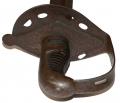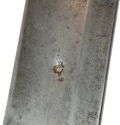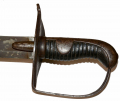site search
online catalog
ICONIC BRITISH PATTERN 1796 HEAVY CAVALRY SABER

$2,495.00 SOLD
Quantity Available: None
Item Code: 88-179
This was the sword of the British Heavy Cavalry during the greater part of the Napoleonic Wars. It was based on an earlier Austrian design. This was the pattern wielded by the Scot's Grays or 2nd Royal North British Dragoons prior to and at Waterloo. Sharpe the rifleman carried one (only in the author of the novel series dreams!). It was the regulation for troopers (enlisted men) of all British the heavy cavalry regiments including the Guards.
This particular example was made by "Osbourne & Gunby" (stamped on the spine) in a contract let out between 1808 and 1812 (all delivered by the Fall of 1812). During its field service the sword had 2 modifications done at the company and regimental level. The first modification was to the blade. It was ground from hatchet point to spear point. This trend began as early as 1812 and by Waterloo, in June 1815, a majority of these swords had undergone the modification - changing them from a "cut" to a "thrust" weapon. In April 1812 Captain William Bragge of the 3rd Dragoons remarked after battle: "It is worthy of remark that scarcely one Frenchman died of his wounds although dreadfully chopped whereas 12 English Dragoons were killed on the spot and others dangerously wounded by thrusts. If our men had used their swords so, three times the number of French would have been killed". The second modification on the sword offered was the grinding of the iron disc guard on the interior. This at first was unofficial and performed at the company/regimental level due to the fact that the guard was chaffing and tearing the buff belts and uniforms. After the Napoleonic War this was officially mandated along with the removal of the guiding languets and often a lighter scabbard substituted. The example we are offering has its languets intact and the original, as made, heavy scabbard.
The condition of the sword is wonderful with the iron surfaces mottled with dark spots and no unsightly heavy pitting. The 35-inch long and 1 -1/2 inch wide single fullered blade is also in fine condition with some surface darker blotches and no pitting. Some several minor contact nicks run down the cutting edge, none deep. It has a deep crown over a number - this is the blade inspector's final proof mark. The wooden grips are covered with 99% of their original leather; these were made without wire. A fine untouched example of a famous sword. [sr][ph:L]
~~~~~~~~~~~~~~~~~~~~~~~~~~~~~~~~~~~
THIS ITEM, AS WITH ALL OTHER ITEMS AVAILABLE ON OUR WEB SITE,
MAY BE PURCHASED THROUGH OUR LAYAWAY PROGRAM.
CLICK HERE FOR OUR POLICIES AND TERMS.
THANK YOU!
Inquire About ICONIC BRITISH PATTERN 1796 HEAVY CAVALRY SABER
For inquiries, please email us at [email protected]
Most Popular
Historical Firearms Stolen From The National Civil War Museum In Harrisburg, Pa »
Theft From Gravesite Of Gen. John Reynolds »
Cavalry Carbine Sling Swivel »
Fine Condition Brass Infantry Bugle Insignia »
featured item
REMARKABLE SWORD IDENTIFIED TO GEORGE WILLIAM GORDON (1801-1877), US CONSUL TO BRAZIL (1840-46) AND SLAVE TRADE OPPONENT
A remarkable sword manufactured by W.H. Horstmann & Co., New York after the Model 1834 US Revenue Cutter/Marine sword. Neatly engraved on the reverse folding guard, “Geo. Wm. Gordon / United States Consul”. Born on February 8, 1801 in Exeter,… (870-60). Learn More »















